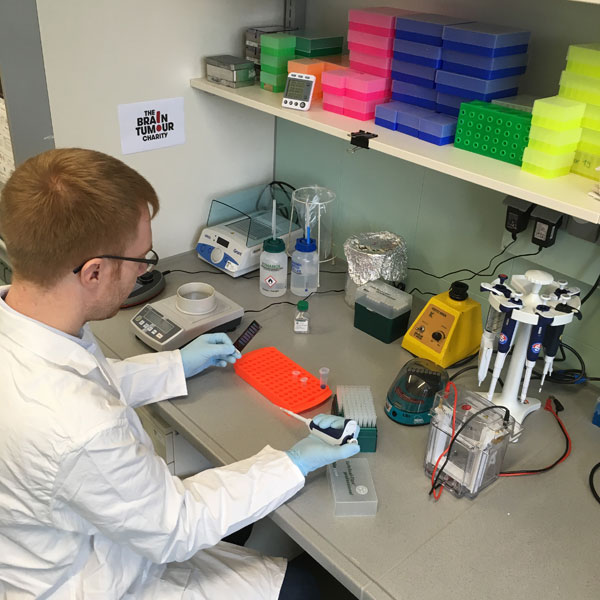We are excited to announce we will be funding a further £5 million for the next five years of research. This follows the achievements since 2017, when The Everest Centre was established.
The Everest Centre is a collaborative research centre that brings together world-leading experts from Germany and the UK at:
- The Hopp Children’s Cancer Center (KiTZ) in Heidelberg, Germany
- The German Cancer Research Centre (DKFZ) in Heidelberg and Charité University Hospital in Berlin, Germany
- University College London
- Queen Mary University of London
The research focuses on low-grade glioma brain tumours that affect children. And aims to further understand, diagnose and find new treatments for these tumours.
Why is this important?
Over 400 children (aged between 0-14) receive a brain tumour diagnosis each year in the UK. Of these, approximately half are low-grade tumours.
We urgently need better treatments due to the limited ways to treat these tumours. Standard treatment includes chemotherapy, radiotherapy and high risk surgery. All of which have a significant impact on a child’s quality of life. The Everest Centre aims to change this through pioneering research.
The Everest Centre
The centre is funded by The Brain Tumour Charity thanks to the generosity and dedication of Everest in the Alps. An event that sees a group of alpine skiers tackling a number of physically and mentally demanding challenges to climb the equivalent height of Mt. Everest (8848m of elevation) in the Alps. Across a series of treks on skis, the teams have raised millions of pounds for The Charity. The Everest Centre was set up with this money.
The inspiration behind these challenges came when Rob Ritchie’s son, Toby was diagnosed with a low-grade brain tumour aged 5. He wanted to do all he could to improve the lives of children living with low-grade brain tumours. So he began raising money by bringing teams together to climb Everest in the Alps.

The success of the Everest Centre is a result of a network of researchers striving to improve the treatment options and quality of life for children diagnosed with low-grade brain tumours. The last five years of research have seen lots of advances in research, with over 50 scientific papers published.
Since 2017, researchers have been working towards developing better tumour models, accelerating new clinical trials with a focus on quality of life for those diagnosed and improving knowledge on the biology of tumour cells and how they interact with the immune system.
Five highlights from The Everest Centre’s achievements in the last five years:

- Research led to fundamental changes in the World Health Organisation’s classification of low-grade brain tumours. Paediatric tumours gained their own category for the first time. This was a huge collaborative effort across Everest researchers.
- Testing of drugs, such as ulixertinib, which have potential as new treatments for low-grade tumours in children.
- Creation of new lab models for low-grade tumours. This could be used to understand the key mechanisms driving the growth and behaviour of different cells within a tumour, and to allow potential new treatments to be more rapidly and reliably screened.
- Creation of important databases for collecting data on low-grade brain tumours and quality of life. Having all this information will help scientists to explore how the tumours develop and enhance quality of life by identifying ways to reduce the burden of treatment toxicity.
- Improved understanding of sleeping (or ‘senescent’) cells in low-grade tumours and how these cells can be treated in new ways – they are typically more resistant to standard chemotherapy since they are not actively multiplying like other cancer cells.
Five things The Everest Centre hopes to achieve in the next five years:
- Gaining a better understanding of the cells in low-grade brain tumours to identify new ways to block their growth. And finding new ways to predict which patients will benefit most from different treatment options being tested in clinical trials.
- Using cutting edge technology such as Artificial Intelligence (AI) to develop improved diagnostic tests and enable a more precise tumour classification. This will ensure children receive the best possible treatment tailored to their specific needs.
- Using models previously developed by The Everest Centre for an in-depth analysis of key pathways important for cancer cell growth, and for exploring new treatment options that could more efficiently block these tumour growth signals.
- Investigating the ways in which tumour cells communicate with other normal cell types in their surroundings, with a particular focus on the body’s immune system and whether this can be re-trained to fight tumour cells.
- Setting up clinical trials that have a clear focus on maintaining excellent overall survival rates while improving the quality of life for patients.
Find out more about The Everest Centre here.
Neil Dickson MBE, Founder of The Brain Tumour Charity and Vice Chairmen of Trustees said:
“As the Chairman of the research committee I was delighted we were able to award this extension to the Everest Centre.
“We were one of the first Charities in the world to fund research into low–grade brain tumours. Dr David Jones completed some ground breaking research into paediatric low–grade tumours at the University of Cambridge, funded by us. He then moved to Heidelberg where he is now the lead scientist and professor leading the Everest Centre.
“The Centre has made amazing progress and is now a world class expert in this tumour type. The great financial support coordinated by the Ritchie family shows that, by working together, we can make real progress in research into brain tumours.”
